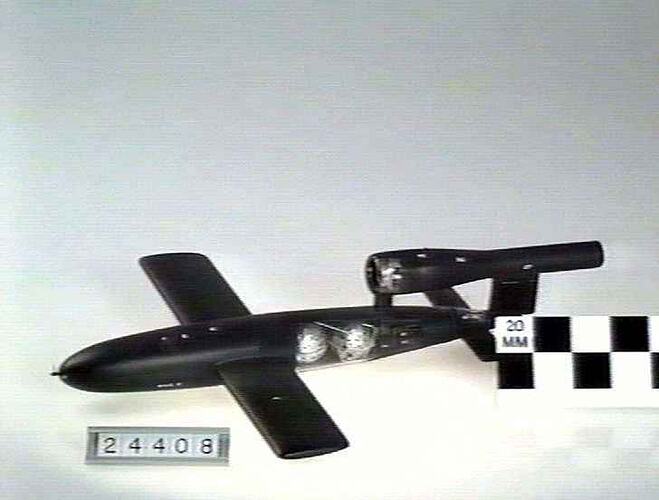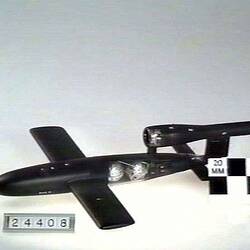Summary
Aircraft History
Designed by the Gerhard Fieseler Werke, the FZG76 or Fi 103 pilotless cruise missile became better known as the V1. Adolf Hitler planned to use the jet-powered V1 and the V2 rocket as 'Vergeltungswaffen' or vengenance weapons against the United Kingdom. The first V1s were launched from 55 metre inclined ramps positioned near the northern French coast and aimed at London. An 850 kilogram explosive charge was carried in the nose cone and power was delivered by an Argus AS 014 impulse duct (pulse jet) engine which used shutters and a screen of fuel nozzles to ignite the fuel and close the shutters in sequence about 40-45 times per second to direct the thrust to the jet pipe which gave out a distinctive rasping noise. Top speed was around 650 kilometers per hour which made it difficult for allied fighters to intercept it in flight. An air driven gyro was used for the flying controls and a normal range of about 240 kilometres It is believed about 10,000 V1s were fired at targets in Britain and Belgium in 1944-45 causing 24,000 casualties. In Britain the V1 was widely known as the 'doodle-bug' or 'buzz-bomb'. In 1944, a concentration camp known as 'Dora' was opened at the site of a massive tunnel complex in the Hartz Mountains in Germany where V1 and V2 weapons were made. Around 20,000 slave labourers are believed to have been killed by the Nazis in the course of the program.
Many V1s were shot down by allied pilots and anti-aircraft guns. Due to the loss of launch sites to allied ground forces, an increasing number of V1s were air-launched from Luftwaffe bombers. An experimental piloted version was also built. A V1 was brought to Australia in 1946 for the Australian War Memorial where it is now displayed.
Model History
This 1:24 scale model was commissioned by the Museum and built by B.D Hede. It was delivered in 1958
More Information
-
Collecting Areas
-
Acquisition Information
Purchase
-
Manufacturer of Item Modelled
-
Modelmaker
Mr B. D. Hede, Glenroy, Greater Melbourne, Victoria, Australia, 1958
-
Classification
Air transport, Aircraft, Model pilotless pulse jet aircraft - military
-
Category
-
Discipline
-
Type of item
-
Model Scale
1:24
-
Keywords
Aeroplanes, Military Aircraft, Model Aeroplanes, Scale Models


